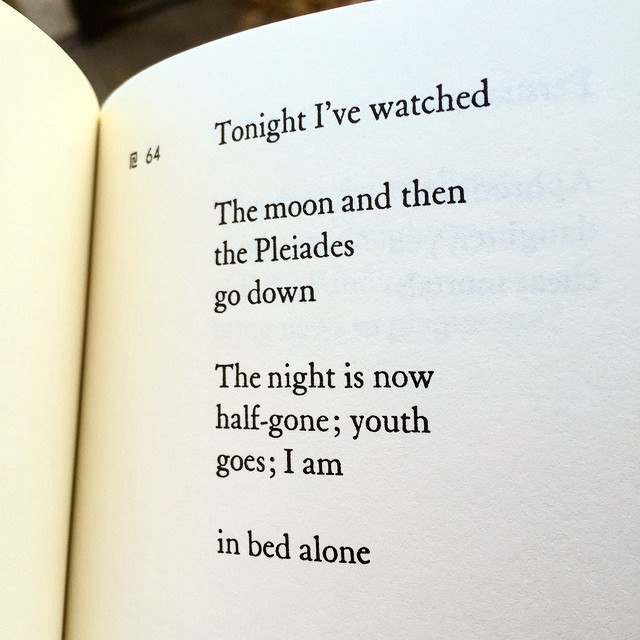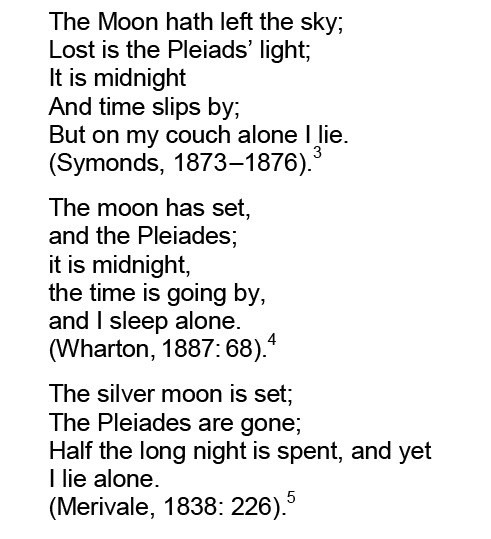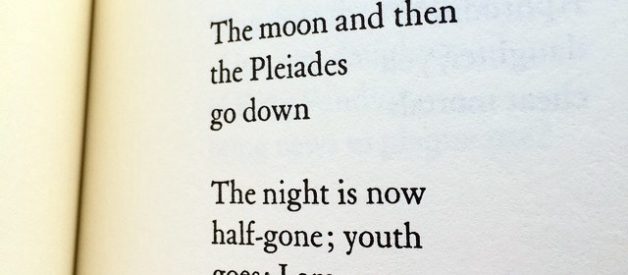
This is one of my favorite poems by the ancient Greek poet Sappho. She was a master of packing a lot into a very tiny lyric ? which is good since, tragically, only 200 scraps of her verse survive. This one is magnificent. In a mere eight lines, she paints the melancholy of middle age onto the canvas of the night sky.
There?s something else about this poem, though: Its astronomical specificity!
Sappho talks about the Pleiades, a cluster of extremely bright stars near Taurus. What?s more, Sappho mentions two interesting facts:
- she watches the Pleaides go down, sinking beneath the horizon. And ?
- ? this occurs before midnight.
Recently, two scientists got interested in the poem, because they realized these two facts could be used to determine precisely what time of year Sappho wrote the poem.
After all, constellations change their position in the sky as the year progresses. That means in different months they?ll sink beneath the horizon at different times of day. Since we know that Sappho saw the Pleiades go down before midnight, first you have deduce where Sappho was located ? geographically ? when she wrote the poem (because this will determine what part of the sky she was looking at). Then you check the star charts from that vantage point, and figure out what time of the year the Pleiades would have been visible right until midnight.
That?s what the scientists did, in their fascinating paper ?Seasonal Dating of Sappho?s ?Midnight Poem? Revisited?.
You can read the paper here ? it?s really fun ? but the tl;dr is this: They started by working with the year 570 BCE, around the time that Sappho died. (This year is, they admit, fairly arbitrary; but a deviation of a few years wouldn?t change the position of the Pleaides noticeably.) They assumed that she wrote the poem in Mytilene, which was the capital city of the island of Lesbos, and where most scholars suspect Sappho lived at that point in her life.
Then they used a bunch of software, including Starry Night, to visualize the night sky from precisely Sappho?s vantage point. They discovered that Sappho could have seen the Pleiades before midnight from the late winter until the early spring.
To quote the paper for more precision:
Assuming that Sappho observed from Mytilene on the island of Lesbos, we determined that in 570 BC the Pleiades set before midnight from 25 January on, and were lost to the evening twilight completely by 6 April.
As one of the scientists noted, this is one of the rare pieces of literature with which one can engage in this sort of analysis, because typically writers aren?t quite so exact in their descriptions of astronomical events:
?Sappho should be considered an informal contributor to early Greek astronomy as well as to Greek society at large,? Cuntz added. ?Not many ancient poets comment on astronomical observations as clearly as she does.?
True, though there have been some other surprisingly nuanced bits of astronomy tucked into literature. As Jennifer Oulette notes in a terrific post in Gizmodo, Donald Olsen ? a ?forensic astronomer? ? has used astronomic calculations to analyze several works of art; he concluded, for example, ?that Mary Shelley was probably telling the truth about a moonlit ?waking dream? that inspired her to pen Frankenstein.? And the Pleiades have cropped up in other famous poems, including ?On the Beach at Night? by Walt Whitman ?
Up through the darkness,While ravening clouds, the burial clouds, in black masses spreading,Lower sullen and fast athwart and down the sky,Amid a transparent clear belt of ether yet left in the east,Ascends large and calm the lord-star Jupiter,And nigh at hand, only a very little above,Swim the delicate sisters the Pleiades.
? and Tennyson?s ?Locksley Hall? ?
Many a night I saw the Pleiads, rising thro? the mellow shade,Glitter like a swarm of fire-flies tangled in a silver braid.
And John Milton crammed so much astronomy into Paradise Lost that there?s an entire book devoted to analyzing it (written in 1913, and thus freely downloadable for your reading pleasure!)
By the way, if you google this Sappho poem, you probably won?t find the precise translation in my picture above, because it?s not online. It?s from a book of Sappho translated by Mary Barnard, who is hands-down my absolute fave. Her renditions rock like a Rush concert; accept no substitutes, and in particular try to get your hands on the University of California printing, which is aesthetically lovely and out of print. To give you a sense of how superior are her translations, read the one I snapped a pic of above, then compare it to these three that are quoted in the scientific paper:

Those are okay, but they lack the deft, bleak drama of Barnard?s version.
Particularly her second stanza! Night is ?half-gone?, but youth goes; the former is a factual statement about this particular night, then the latter pulls the camera back about sixteen miles and boom, you behold the existential arc of a life. Then she leaves you with that little hang at the end of ?I am? ? and nails it to the wall with the final line.
Completely metal.
(This post originally appeared here on Clive?s personal blog!)


